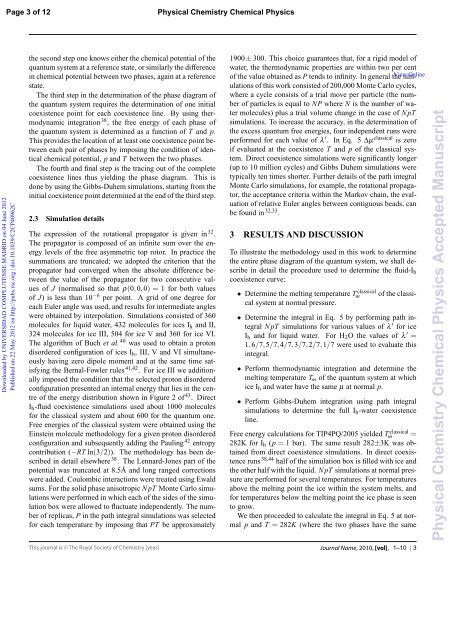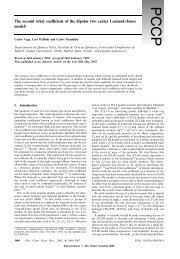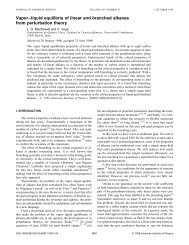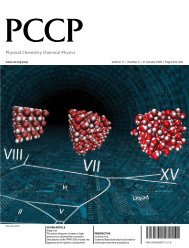Accepted Manuscript
Accepted Manuscript
Accepted Manuscript
Create successful ePaper yourself
Turn your PDF publications into a flip-book with our unique Google optimized e-Paper software.
Page 3 of 12 Physical Chemistry Chemical Physics<br />
Downloaded by UNIVERSIDAD COMPLUTENSE MADRID on 04 June 2012<br />
Published on 22 May 2012 on http://pubs.rsc.org | doi:10.1039/C2CP40962C<br />
the second step one knows either the chemical potential of the<br />
quantum system at a reference state, or similarly the difference<br />
in chemical potential between two phases, again at a reference<br />
state.<br />
The third step in the determination of the phase diagram of<br />
the quantum system requires the determination of one initial<br />
coexistence point for each coexistence line. By using thermodynamic<br />
integration 38 , the free energy of each phase of<br />
the quantum system is determined as a function of T and p.<br />
This provides the location of at least one coexistence point between<br />
each pair of phases by imposing the condition of identical<br />
chemical potential, p and T between the two phases.<br />
The fourth and final step is the tracing out of the complete<br />
coexistence lines thus yielding the phase diagram. This is<br />
done by using the Gibbs-Duhem simulations, starting from the<br />
initial coexistence point determined at the end of the third step.<br />
2.3 Simulation details<br />
The expression of the rotational propagator is given in 32 .<br />
The propagator is composed of an infinite sum over the energy<br />
levels of the free asymmetric top rotor. In practice the<br />
summations are truncated; we adopted the criterion that the<br />
propagator had converged when the absolute difference between<br />
the value of the propagator for two consecutive values<br />
of J (normalised so that ρ(0,0,0) = 1 for both values<br />
of J) is less than 10 −6 per point. A grid of one degree for<br />
each Euler angle was used, and results for intermediate angles<br />
were obtained by interpolation. Simulations consisted of 360<br />
molecules for liquid water, 432 molecules for ices Ih and II,<br />
324 molecules for ice III, 504 for ice V and 360 for ice VI.<br />
The algorithm of Buch et al. 40 was used to obtain a proton<br />
disordered configuration of ices Ih, III, V and VI simultaneously<br />
having zero dipole moment and at the same time satisfying<br />
the Bernal-Fowler rules 41,42 . For ice III we additionally<br />
imposed the condition that the selected proton disordered<br />
configuration presented an internal energy that lies in the centre<br />
of the energy distribution shown in Figure 2 of 43 . Direct<br />
Ih-fluid coexistence simulations used about 1000 molecules<br />
for the classical system and about 600 for the quantum one.<br />
Free energies of the classical system were obtained using the<br />
Einstein molecule methodology for a given proton disordered<br />
configuration and subsequently adding the Pauling 42 entropy<br />
contribution (−RT ln(3/2)). The methodology has been described<br />
in detail elsewhere 38 . The Lennard-Jones part of the<br />
potential was truncated at 8.5 ˚A and long ranged corrections<br />
were added. Coulombic interactions were treated using Ewald<br />
sums. For the solid phase anisotropic N pT Monte Carlo simulations<br />
were performed in which each of the sides of the simulation<br />
box were allowed to fluctuate independently. The number<br />
of replicas, P in the path integral simulations was selected<br />
for each temperature by imposing that PT be approximately<br />
1900±300. This choice guarantees that, for a rigid model of<br />
water, the thermodynamic properties are within two per cent<br />
of the value obtained as P tends to infinity. In general the simulations<br />
of this work consisted of 200,000 Monte Carlo cycles,<br />
where a cycle consists of a trial move per particle (the number<br />
of particles is equal to NP where N is the number of water<br />
molecules) plus a trial volume change in the case of N pT<br />
simulations. To increase the accuracy, in the determination of<br />
the excess quantum free energies, four independent runs were<br />
performed for each value of λ ′ . In Eq. 5 Δμ classical is zero<br />
if evaluated at the coexistence T and p of the classical system.<br />
Direct coexistence simulations were significantly longer<br />
(up to 10 million cycles) and Gibbs Duhem simulations were<br />
typically ten times shorter. Further details of the path integral<br />
Monte Carlo simulations, for example, the rotational propagator,<br />
the acceptance criteria within the Markov chain, the evaluation<br />
of relative Euler angles between contiguous beads, can<br />
be found in 32,33 View Online<br />
.<br />
3 RESULTS AND DISCUSSION<br />
To illustrate the methodology used in this work to determine<br />
the entire phase diagram of the quantum system, we shall describe<br />
in detail the procedure used to determine the fluid-Ih<br />
coexistence curve:<br />
• Determine the melting temperature T classical<br />
m of the classical<br />
system at normal pressure.<br />
• Determine the integral in Eq. 5 by performing path integral<br />
N pT simulations for various values of λ ′ for ice<br />
Ih and for liquid water. For H2O the values of λ ′ =<br />
1,6/7,5/7,4/7,3/7,2/7,1/7 were used to evaluate this<br />
integral.<br />
• Perform thermodynamic integration and determine the<br />
melting temperature Tm of the quantum system at which<br />
ice Ih and water have the same μ at normal p.<br />
• Perform Gibbs-Duhem integration using path integral<br />
simulations to determine the full Ih-water coexistence<br />
line.<br />
Free energy calculations for TIP4PQ/2005 yielded T classical<br />
m =<br />
282K for Ih (p = 1 bar). The same result 282±3K was obtained<br />
from direct coexistence simulations. In direct coexistence<br />
runs 38,44 half of the simulation box is filled with ice and<br />
the other half with the liquid. N pT simulations at normal pressure<br />
are performed for several temperatures. For temperatures<br />
above the melting point the ice within the system melts, and<br />
for temperatures below the melting point the ice phase is seen<br />
to grow.<br />
We then proceeded to calculate the integral in Eq. 5 at normal<br />
p and T = 282K (where the two phases have the same<br />
1–10 | 3<br />
Physical Chemistry Chemical Physics <strong>Accepted</strong> <strong>Manuscript</strong>










